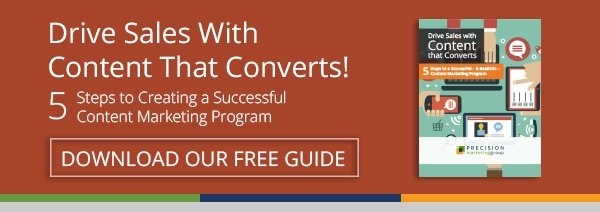Do you love the thrill of creating a great marketing campaign concept? Coming up with an awesome tagline for your company or subject line for your email blast? Designing a beautiful, high-functioning website?
For many of us marketers, the creative side of marketing is the most enjoyable part. But does it really matter if your marketing is magical if your target buyer never responds to it? Will sales shine if your marketing sputters with your key audiences?
You know that sales starts with targeting a prospective set of buyers. Your marketing has to start there, too.
The term “buyer personas” is the latest phrase permeating the content around this topic and some marketers are advocating an insanely deep dive into each type of person who could potentially consume your content marketing. I am not sure you need to have a made up life story of a fictitious person, complete with hobbies and favorite travel spots, to produce marketing that makes you money.
In keeping with our passion for practical marketing, here at PMG we aim for a more “down and dirty” yet effective approach to create and use buyer personas in your marketing.
How to Create Your Buyer Personas
1. Create a master list of the various types of people who are involved in the buying process of your product/service. Get as granular as you can – are they typically male of female? How old are they? What is their job title? What types of responsibilities do they have? How are they evaluated? Your list will include:
-
Ideal buyers/decision makers
-
Ideal users
-
Ideal influencers
2. Decide how many personas you will create from your master list. You can always start with the top three and then add more later.
3. For each persona, identify three people who you have engaged in your buying process recently – whether or not they chose to buy. Sometimes the best insights will come from lost prospects, so don’t lose sight of this key audience.
4. Arrange a brief interview – make it a conversation and not a survey – with each person. Ask for no more than 20 minutes of their time and always send a handwritten thank you note to people who agree to give their time to this process.
5. Your interviews should aim to uncover the following things:
-
The pain, problem or challenge that inspired the buyer to seek the solution your company provides
-
What type of research was done to identify potential providers of your product or service – did they ask for referrals, do online research, attend industry events, etc.
-
Who else was involved in the buying decision? What was the process?
-
How were potential providers evaluated – price, options, service, etc.?
-
Was there one thing about a potential provider that caused them to perk up and want to learn more?
-
What is the ultimate deal breaker during the buying process – a long-term contract, lack of experience in their industry, etc.?
-
What was their overall impression of the buying experience with your company – from materials presented to individuals who participated in the process, etc.?
6. Once you have gathered the information from three real individuals who represent this target customer, you can create your persona. You can get very detailed or keep it simple. Here are some great examples from HubSpot. We recommend that your buyer personas at the very least include:
-
Job title/responsibilities
-
Pain points/challenges your product/service can address
-
How he/she researches options
-
How he/she makes buying decisions
-
Content he/she finds most valuable related to your product/service
-
How does he/she like to be communicated with
How to Use Your Buyer Personas
Besides serving as a valuable resource for your sales team, your personas play a critical role in helping you create marketing strategies and content that resonates more successfully with the people who matter most.
Use your buyer personas when:
-
Deciding if/where to advertise
-
Optimizing your online content
-
Creating ideas for article pitches in trade/industry outlets
-
Generating ideas for blog posts, eBooks, white papers and guides
-
Identifying which content to present to prospects during the buying process
The good news is that creating and using buyer personas does not have to suck the fun out of creating a great marketing campaign. It simply makes the process more strategic and, ultimately, more successful for your company.




